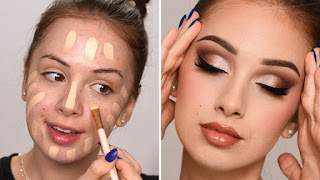INTRODUCTION TO MAKEUP BASE AND SKIN TYPES
If you know nothing about makeup, or if you're learning about makeup and you need a review of the basics, then this is the post for you. Consider this your ultimate introduction to makeup and the world of various makeup products.
Below we've listed every type of makeup, along with a quick description of what it is, and how it's used.
There are over 20 makeup types in all, and we discuss each in detail, and then, all the way at the bottom, we talk about the order of makeup application.
ABOUT MOISTURIZER
A moisturizer is any mixture that protects skin by keeping it hydrated. It's kind of the super-hero of your makeup collection: it can keep you from developing wrinkles, retain the water and oils in your skin so that the wrinkles that you do have don't look exaggerated, and it provides a reliable base for your makeup (and we'll talk more about that in a second). It creates a protective layer on your epidermis---that is, the top layer of your skin---to keep moisture and oils in.Basically, there are two different types of moisturizers: the kind you wear before you put on your makeup, and the kind you put on at the end of the day, before you go to sleep cosmetics companies make products for oily and/or acne-prone skin, dry skin, sensitive skin, and aging skin. There are non organic and organic varieties. They also make moisturizer with sunscreen, which, if you're putting it on at the beginning of the day (which you should), will protect you from harmful UV radiation from the sun.Remember before, when we said that moisturizer provides a reliable base for your makeup? That's one of its most important aspects. Just like a good foundation, moisturizer keeps your face in place. It doesn't matter if you have the most expensive makeup in the world---if you haven't prepared your skin to wear makeup, professional makeup artists spend just as much time preparing their models' skin (that is, cleaning it and moisturizing it) as they do *actually applying makeup.* That truly shows how important it is to moisturize properly.
Skin types
There are five basic skin types, including:1. Normal skin
This type of skin has a fine, even and smooth surface due to its ideal balance between oil and moisture content and is therefore neither greasy nor dry. People who have normal skin have small, barely-visible pores. Thus, their skin usually appears clear and does not frequently develop spots and blemishes. This type of skin needs minimal and gentle treatment, but does still require maintenance.
2. Dry skin
Dry skin has a parched appearance and tends to flake easily. It is prone to wrinkles and lines due to its inability to retain moisture, as well as an inadequate production of sebum by sebaceous glands. Dry skin often has problems in cold weather, which dries it out even further. Constant protection in the form of a moisturizer by day and a moisture-rich cream by night is essential. It is important not to over-exfoliate even in cases of extreme flaking, as this only dries out the skin further; gentle exfoliants using sugar, rice bran or mild acids are the most suitable, although they should not be used more frequently than once per week to avoid causing irritation and dryness.
3. Oily skin
As its name implies, this type of skin surface is slightly to moderately greasy, which is caused by the over secretion of sebum. The excess oil on the surface of the skin causes dirt and dust from the environment to adhere to it. Oily skin is usually prone to blackheads, whiteheads, spots and pimples. It needs to be cleansed thoroughly every day, especially in hot or humid weather. Moisturizing with an oil-free, water-based and non-comedogenic moisturizer is required in addition. Exfoliation is also necessary, but over-exfoliation can cause irritation and increase in oil production; exfoliants that contain fruit acids are particularly helpful, and fine-grained exfoliants may help to clear blocked pores, discouraging breakouts and improving the skin's appearance.
4. Combination skin
5. Sensitive skin
Sensitive skin has a tendency to react to many potential triggers with irritation, redness, stinging or burning, flaking, lumpiness and rashes. The most common causes of irritation are chemical dyes and fragrances, soaps, some flower and spice oils, shaving creams, tanning lotions or spray tans, changes in temperature, excessive cleansing or exfoliating, waxing, threading, shaving and bleaching. People with sensitive skin should try to avoid products with unnecessary fragrances or dyes, and generally avoid using products that cause irritation. Sensitive skin is typically dry, but can be oily, normal or combination as well.






Comments
Post a Comment